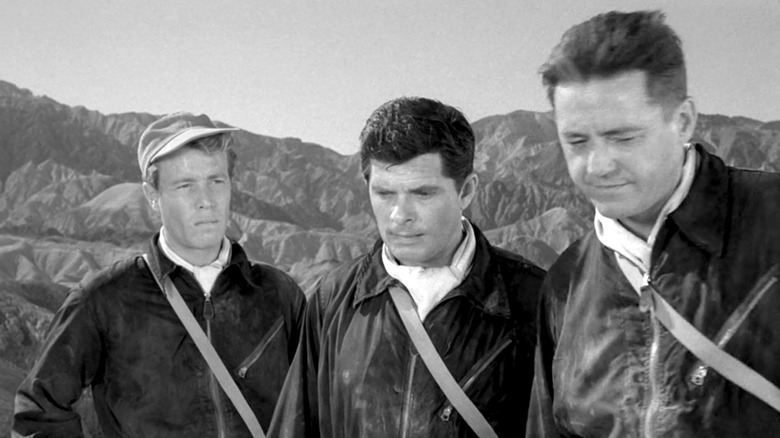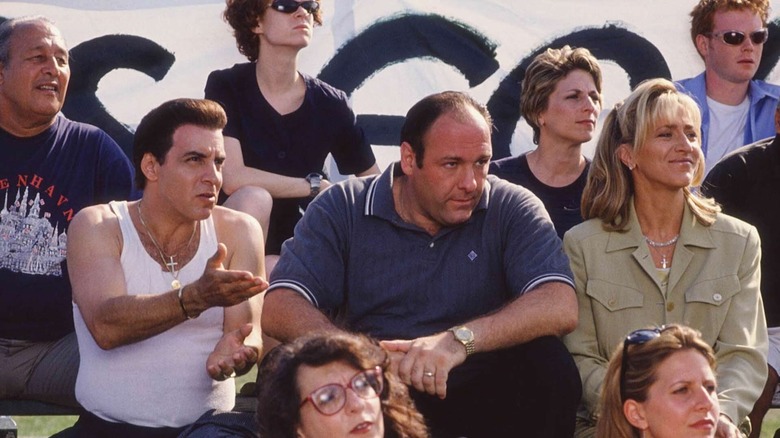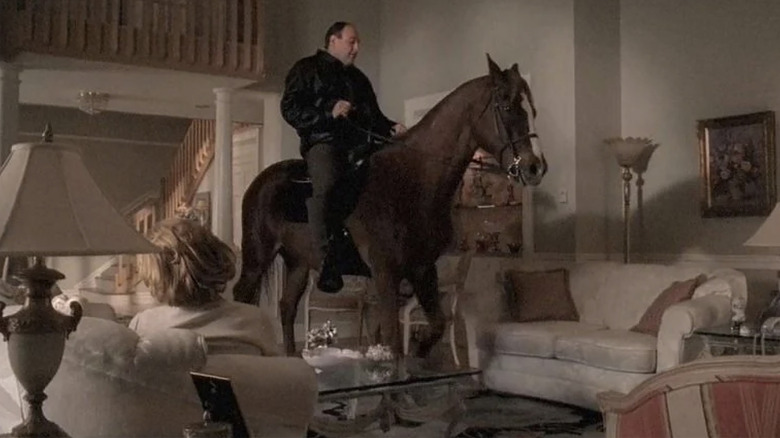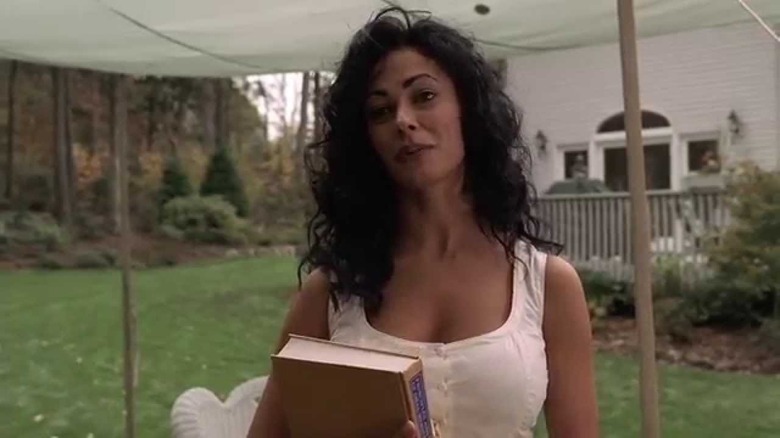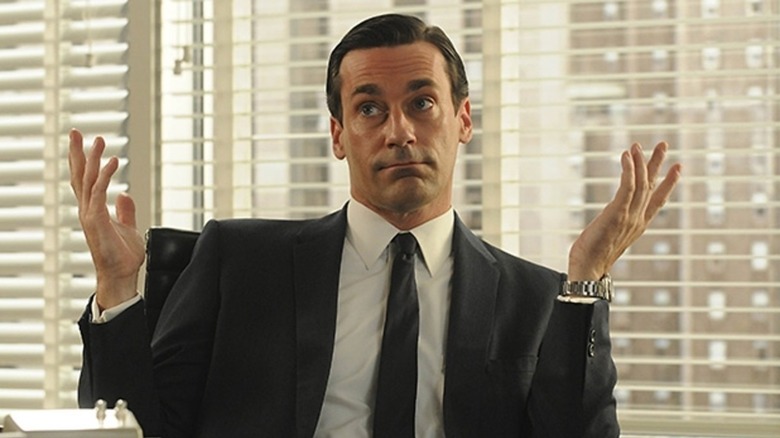How The Twilight Zone Influenced The Sopranos
When the first episode of "The Twilight Zone" aired, "The Sopranos" creator David Chase was a freshman in high school. As Chase himself put it in a recent column for Variety, the show "made a mammoth impression." The series, with its bold anthology format and its love of the surreal, would go on to have a clear influence on how Chase went about his own TV show, despite its more serialized and realistic format. "The Twilight Zone" might've technically ended in 1964, but it stuck in Chase's mind long afterward.
"From the opening, where writer Rod Serling came out in his herringbone jacket with his cigarette and introduced the show: That, in itself, was entertaining," Chase wrote. "I just wanted to hear what Rod had to say about the mystery of the universe this time out." Serling was a writer with a lot to say about American culture, and despite the many restrictions of working in TV at the time, he managed to use his show's format to speak his mind. Chase talked about one of his favorite episodes, "I Shot an Arrow Into the Air," and how it used its premise as an avenue for social commentary, a technique Chase himself was happy to use:
"The arguments the astronauts had touched on themes in American life, like all the episodes did, just like when Tony Soprano says, 'I have the feeling I came in at the end.' That wasn't about the Mafia."
Sure enough, the sci-fi/fantasy elements were to "The Twilight Zone" what the mafia elements were to "The Sopranos" — a roundabout way of talking about regular life in contemporary America.
Influencing the early seasons in particular
Chase brought up the season 4 "Sopranos" episode, "Christopher," as an example of Rod Serling's influence. "The episode everyone hates," he called it. "That's about America at its ludicrous worst." Sure enough, the episode is indeed one of the most controversial of the series, as it takes a break from most of the compelling serialized storylines of the season to give us an episode where all the characters suddenly have really strong opinions about Christopher Columbus.
The episode features a beef between Tony's crew and a group of Native American activists, as well as some out-of-character moments for Silvio, who is inexplicably the angriest about Christopher Columbus being disrespected. (It seems clear that Silvio's role was originally supposed to go to Paulie, but Paulie was in jail at the time due to real-life health problems with the actor.)
"Christopher" is widely disliked, but not because it's bad, exactly. It's disliked because it feels like the sort of episode the show would've given us back in season 1. From season 1's Very Special Episode about Meadow's soccer coach being a sexual predator, to its storyline about the prevalence of ADD diagnoses in kids, season 1 of "The Sopranos" was a lot more comfortable with using its Mafia premise as a way to deliver straightforward social commentary about American life. But as "The Sopranos" went on and embraced a more subtle, nuanced approach to its social commentary, a "Twilight Zone"-style episode felt increasingly out of place. By season 4, the '60s anthology show's influence on the HBO drama had less to do with the social commentary and a lot more to do with the surreal, dreamlike elements.
Embracing the otherworldly
"I also believe ["The Twilight Zone"] had something to do with the psychedelic revolution that happened later," Chase wrote. "Kids who watched it were somehow ready to accept what happens with LSD or to be curious about LSD. Without 'The Twilight Zone,' it might not have been such a revolution." It was a revolution Chase credits, at least partially, for the dream sequences and the occasional hints of the supernatural throughout his show.
This was another controversial aspect of the series; even today, I hear some fans talk about how they prefer to skip over those coma episodes in season 6 or that 20-minute dream sequence in season 5. But these dream sequences also create some of the most striking, emotional imagery of the whole show. That quiet scene of Tony alone in that empty hotel room in "Join the Club" is a haunting moment, one that really captures Tony's loneliness and makes us think there's more going on here than just Tony dreaming.
Part of why those sequences are so notable is that considering most mainstream audiences seemingly just want a straightforward plot about mobster shenanigans, it's hard to believe the show got away with its extended artsy dream sequences. The audacity of that approach is something Chase seems to have picked up from Serling as well. "As interesting as Rod Serling was, I would love to get into the brains of the people at CBS who said OK to this series," Chase wrote. "TV was ruled by fear and greed, and the network executives, sorry to say, are often not that bright. So what happened with 'The Twilight Zone'?" As we watch Tony ride a horse into his living room, we can just as easily ask, "What happened with 'The Sopranos'?"
The plot twists
Part of why the "Twilight Zone" episode "I Shot an Arrow Into the Air" stuck out so much to David Chase is its big final twist, a plot device the show became well-known for. As Chase explained:
"That was my introduction to the twist. My first writing lesson. Sure, you can make the case that a twist is one of the cheaper forms of art. But it just tore my brain up, and I never forgot it."
This might seem like a weird thing to point out concerning "The Sopranos," as that show didn't really utilize plot twists that often. When there is an unexpected plot swerve, it usually comes from the character's choices rather than any new reveal of information. Rod Serling's influence on the later show, in this respect, is instead limited to the early seasons: Season 1's "Boca" gives us the giant plot twist that Meadow's soccer coach is actually a sexual predator, and a few episodes later "Isabella" gives us the reveal that the seductive neighbor girl Tony's been talking to has been nothing but a drug-induced hallucination.
The latter in particular is something straight out of "The Twilight Zone," pulling the rug out from audiences in a creepy, disorientating way. However, the show would rarely, if ever, pull a stunt on this level again. As the show went on and further developed its voice, it moved away from this aspect of Serling's storytelling, but the influence is still clear. "The Sopranos" wouldn't have been such a hit without season 1's massive success, and season 1 was the most "Twilight Zone"-inspired season of them all.
Continuing the cycle
It's fitting that so much of "The Sopranos" was partially inspired by other shows because 24 years after its premiere, the mobster drama has now served as the inspiration for a hundred other groundbreaking series. It's hard to watch Walter White in "Breaking Bad," an anti-hero who slips further and further into moral depravity, and not think of Tony. It's hard to watch Kevin in "The Leftovers" spend an entire episode in a quasi-afterlife hotel and not think of Tony being forced to do the same. (It certainly doesn't feel like a coincidence that Tony's alter-ego in the coma episode was also named Kevin.)
Perhaps the clearest spiritual successor to "The Sopranos" is "Mad Men," which borrows the former's approach of constantly exploring the contradiction between the main characters' facades and how they actually are. Both shows structure their episodes in a sort of short-story format, and both are keenly interested in staying true to the changing times the characters live in. Most people aren't surprised when they hear that the "Mad Men" showrunner used to write for "The Sopranos," because the shows have so much in common despite their characters' different professions.
Just as Chase was inspired by a TV show that ended over forty years before his show began, we wouldn't be surprised if forty years from now there'll still be hit shows coming out inspired by "The Sopranos." Big, influential pieces of art tend to live on long after they've been officially finished, and this mob drama is no exception.
